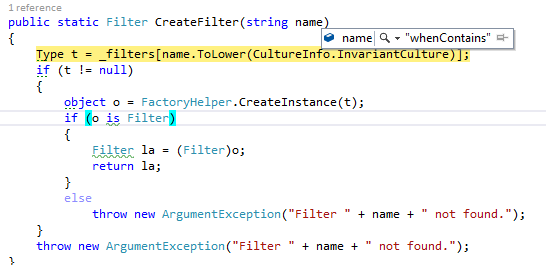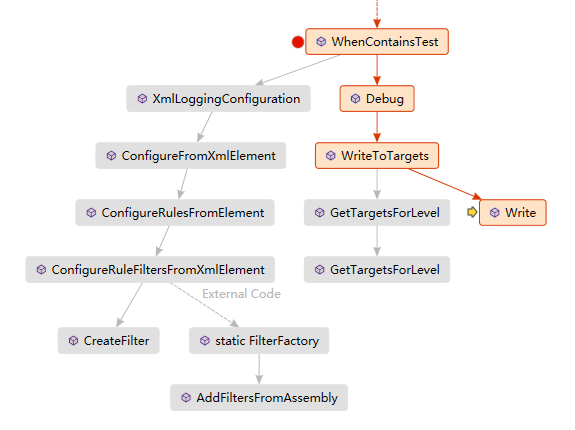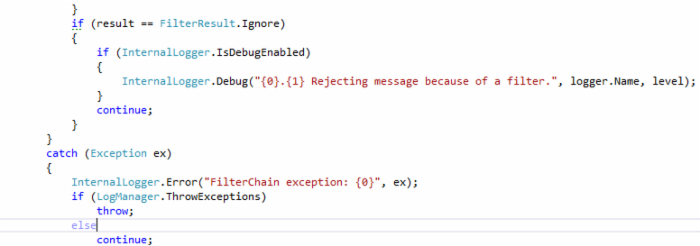NLog详解(四) - filter
我们将版本向前切换到20051025,这期的关注点是filter。我们在使用日志的时候可能希望加上一些过滤器,在满足某些特定条件的时候才输出。举个简单的使用方式如下:
<nlog> <targets><target name='debug' type='Debug' layout='${basedir} ${message}' /></targets> <rules> <logger name='*' minlevel='Debug' appendTo='debug'> <filters> <whenContains layout='${message}' substring='zzz' action='Ignore' /> </filters> </logger> </rules> </nlog> 初始化
FilterFactory负责初始化程序集中的Filter
public sealed class FilterFactory { private static TypeDictionary _filters = new TypeDictionary(); static FilterFactory() { foreach (Assembly a in ExtensionUtils.GetExtensionAssemblies()) { AddFiltersFromAssembly(a, ""); } } 反射初始化的方式和上篇的LayoutRender没有差别
public static void AddFiltersFromAssembly(Assembly theAssembly, string prefix) { try { InternalLogger.Debug("AddFiltersFromAssembly('{0}')", theAssembly.FullName); foreach (Type t in theAssembly.GetTypes()) { FilterAttribute[]attributes = (FilterAttribute[])t.GetCustomAttributes(typeof(FilterAttribute), false); if (attributes != null) { foreach (FilterAttribute attr in attributes) { AddFilter(prefix + attr.Name, t); } } } } catch (Exception ex) { InternalLogger.Error("Failed to add filters from '" + theAssembly.FullName + "': {0}", ex); } } 加载配置文件中的Filter

只是简单的从初始化好的_filters字典里面取出即可,如果发现没有,就会尝试反射创建

执行

还是在 LoggerImpl 的 Write 方法中以链式的方式嵌入
for (TargetWithFilterChain awf = targets; awf != null; awf = awf.Next) { Target app = awf.Target; try { FilterCollection filterChain = awf.FilterChain; FilterResult result = FilterResult.Neutral; for (int i = 0; i < filterChain.Count; ++i) { Filter f = filterChain[i]; result = f.Check(logMessage); if (result != FilterResult.Neutral) break; } if (result == FilterResult.Ignore) { if (InternalLogger.IsDebugEnabled) { InternalLogger.Debug("{0}.{1} Rejecting message because of a filter.", logger.Name, level); } continue; } } 这里可以看到,如果filter 的result 是 Ignore ,该Message的Target就不需要再输出了。
TargetWithFilterChain 是包装Target的关键类型:
internal class TargetWithFilterChain { private Target _target; private FilterCollection _filterChain; private TargetWithFilterChain _next; public TargetWithFilterChain(Target a, FilterCollection filterChain) { _target = a; _filterChain = filterChain; } 这个类型的实现很简单,就是将Target和FilterChain打包放在一起。
InternalLogger
这里值得注意的细节是 InternalLogger 记录了内部一些详情,当我们需要的时候直接开启 InternalLogger 调试日志组件的工作过程。

我们对于 InternalLogger 的要求是不要影响正常程序的运行过程,仅仅在调试日志组件功能的时候使用,因此里面的代码牺牲异常也保证安全。
static InternalLogger() { try { switch (ConfigurationSettings.AppSettings["nlog.internalLogToConsole"].ToLower()) { case "false": LogToConsole = false; break; case "true": LogToConsole = true; break; default: if (EnvironmentHelper.GetSafeEnvironmentVariable("NLOG_INTERNAL_LOG_TO_CONSOLE") != null) { LogToConsole = true; } break; } string levelString = ConfigurationSettings.AppSettings["nlog.internalLogLevel"]; if (levelString == null || levelString.Length == 0) levelString = EnvironmentHelper.GetSafeEnvironmentVariable("NLOG_INTERNAL_LOG_LEVEL"); if (levelString != null && levelString.Length > 0) LogLevel = LogLevel.FromString(EnvironmentHelper.GetSafeEnvironmentVariable("NLOG_INTERNAL_LOG_LEVEL")); LogFile = ConfigurationSettings.AppSettings["nlog.internalLogFile"]; if (LogFile == null) LogFile = EnvironmentHelper.GetSafeEnvironmentVariable("NLOG_INTERNAL_LOG_FILE"); Info("NLog internal logger initialized."); } catch {} } 可以看到 InternalLogger 的开启不依赖于原来的配置文件结构,默认不输出,以及取环境变量处理的也非常小心。
public static string GetSafeEnvironmentVariable(string name) { try { string s = Environment.GetEnvironmentVariable(name); if (s == "") return null; else return s; } catch (SecurityException) { return ""; } } 正文到此结束
热门推荐
相关文章
Loading...











![[HBLOG]公众号](http://www.liuhaihua.cn/img/qrcode_gzh.jpg)

